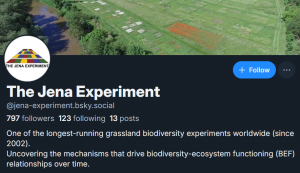New publication from Chen et al. in Nature Communications: Drought-exposure history increases complementarity between plant species in response to a subsequent drought
Drought-exposure history increases complementarity between plant species in response to a subsequent drought Growing threats from extreme climatic events and biodiversity loss have raised concerns about their interactive consequences for ecosystem functioning. Evidence suggests biodiversity can buffer ecosystem functioning during such climatic events. However, whether exposure to extreme climatic events will strengthen the biodiversity-dependent buffering effects for future generations remains elusive.

We assess such transgenerational effects by exposing experimental grassland communities to eight recurrent summer droughts versus ambient conditions in the field. Seed offspring of 12 species are then subjected to a subsequent drought event in the glasshouse, grown individually, in monocultures or in 2-species mixtures. Comparing productivity between mixtures and monocultures, drought-selected plants show greater between-species complementarity than ambient-selected plants when recovering from the subsequent drought, causing stronger biodiversity effects on productivity and better recovery of drought-selected mixtures after the drought. These findings suggest exposure to recurrent climatic events can improve ecosystem responses to future events through transgenerational reinforcement of species complementarity. Drought-exposure history increases complementarity between plant species in response to a subsequent drought.
Reference:
Chen, Y., Vogel, A., Wagg, C. et al. Drought-exposure history increases complementarity between plant species in response to a subsequent drought. Nat Commun13, 3217 (2022). https://doi.org/10.1038/s41467-022-30954-9



